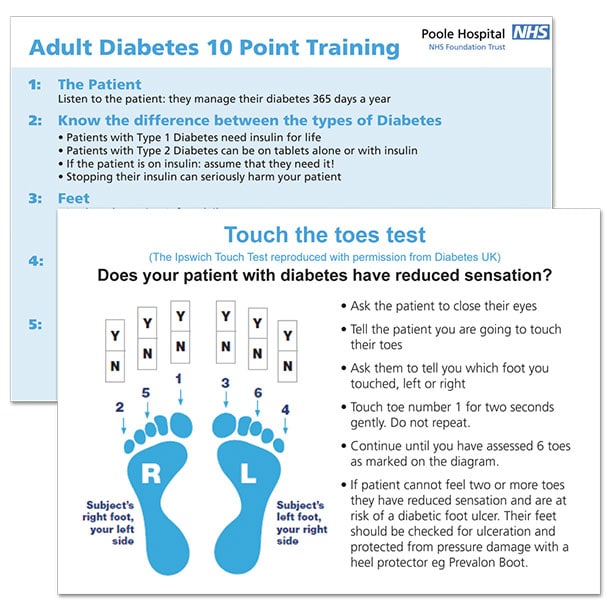Summary
After identifying that clinical commitments represent the major barrier to staff education, a quality improvement project using a novel multidisciplinary education tool ‘Diabetes 10 point training’ was developed and piloted. The ‘10 points’ are derived from the most common insulin and diabetes-related errors seen in practice. Delivery takes place within clinical areas, opportunistically delivering bite-sized chunks in direct response to staff self-identified needs. It is applicable to all healthcare professionals who care for inpatients with diabetes.
Innovation
There is a need for ongoing education that does not draw staff away from their routine duties but is taken to the clinical environment where the content can be adapted to the specific needs of those present. An interprofessional educational tool was developed by Ruth Miller, lead diabetes specialist nurse, which fits in around clinical duties and is pertinent to the specific needs of the individual and clinical area. The tool consists of 10 points which are based upon the most common insulin and diabetes-related errors seen in practice as identified by: national audit data, The National Patient Safety Agency rapid response reports and personal experience. Reference cards with the 10 points listed are given to every participant. The tool has flexibility as the framework can be adjusted as required to meet the needs of each learner group. It can be delivered opportunistically by taking it to clinical environments and inviting people to be trained. Each session is bespoke depending on the needs of the participants, the location and the time available and consists of a discussion led by the participants, facilitated by the specialist team. This is an advance from traditional didactic training methods of blocking out time and requiring large group attendance.
Results
Between January and June 2016, 640 healthcare professionals in the Trust went through the education programme. 230 participants completed the questionnaire prior to training and 99 completed the questionnaire at three months. In every area there was significantly higher confidence after the training compared to before training (p<0.01). The change to patient safety was evaluated by comparing data from the National Diabetes Inpatient Audit (NaDIA) in this hospital in 2015 ( the year before the 10 point training was launched) with those for 2016 ( nine months after the start of our intervention). There has been a large reduction in medication errors, insulin errors, prescription errors and the frequency of hypoglycaemia: with the national average for insulin errors at 38.1% in 2015 and 37.8% in 2016, this moves our Trust from the highest quartile to the lowest quartile within one year. Savings would be expected through the large reduction in the length of stay for patients with diabetes and prevention of complications from medication errors. As staff are not removed from clinical work for training there is no requirement for additional workforce provision.
Dissemination and Sustainability
This tool has been imbedded in cyclical training to all new doctors and nurses and incorporated into annual mandatory staff training programmes. It can be delivered by any specialist in diabetes to any group of healthcare professionals. The system allows rapid ‘training the trainers’ to increase tool delivery and has been endorsed by Diabetes UK following favourable peer review by clinical champions. Ruth Miller presented the development of the tool at The All-Party Parliamentary Group for Diabetes as an example of how to improve inpatient diabetes outcomes. This tool is also being used by Lancashire Teaching Hospitals and the Royal Free Hospital, London. Through collaborating with community matrons we have been delivering this educational tool to community district nurses and nursing assistants in the rural community setting of The Isle of Purbeck. It has also been used successfully for community nurses in Camden, two very diverse areas. Content is adapted to the specific requirements depending on what they are able to prescribe and deliver locally.
Method
From January 2016, each clinical area in our hospital was advised to expect opportunistic ward visits from the inpatient diabetes nurse team offering training. The training was advertised in advance around the Trust on posters, on screen savers, in newsletters and had the support of the Medical Director and the Director of Nursing. Two diabetes specialist nurses carried out ward drop-ins seven days per week and approached all healthcare professionals present (doctors, nurses, nursing assistants, pharmacists, midwives, therapists, ODPs and theatre technicians) inviting them to take part in a short training session in diabetes. Each area was visited several times at different times of the day to maximise uptake of staff members working different shifts. Group sizes were between one and five and this was carried out in the clinical area. The content was based on the 10 point training tool, however this was customised to the specialty of participants present. For example in surgical wards, there were many questions about the use of intravenous insulin and of glycaemic control around nasogastric feeding. On oncology wards the focus was around use of high dose steroids, how and when to treat these patients and how to best manage symptoms of hyperglycaemia in the patient who is already unwell. On the elderly care, ENT and stroke wards the conversations and questions were often around hyperglycaemia due to enteral feeding.




